How To Plant Okra Seeds In A Garden
Okra
Description
Okra, Abelmoschus esculentus, is an herbaceous annual plant in the family Malvaceae which is grown for its edible seed pods. Okra plants have small erect stems that can be bristly or hairless with heart-shaped leaves. The leaves are 10–20 cm (4–8 in) long with 5–7 lobes The plant produces flowers with five white to yellow petals which are 4–8 cm (1.6–3.1 in) in diameter. The seed pod is a capsule up to 25 cm (10 in) long, containing numerous seeds. Okra can grow 1.2–1.8 m (4–6 ft) tall and as an annual plant, survives only one growing season. Okra may also be referred to as lady's fingers and is believed to have originated in Ethiopia.
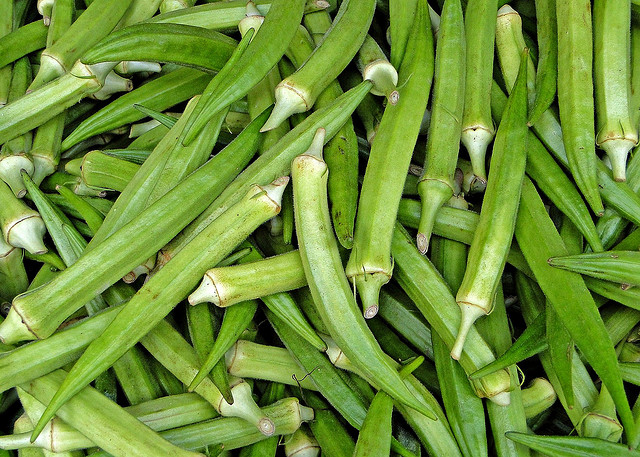
Harvested okra pods

Field of okra

Okra pods
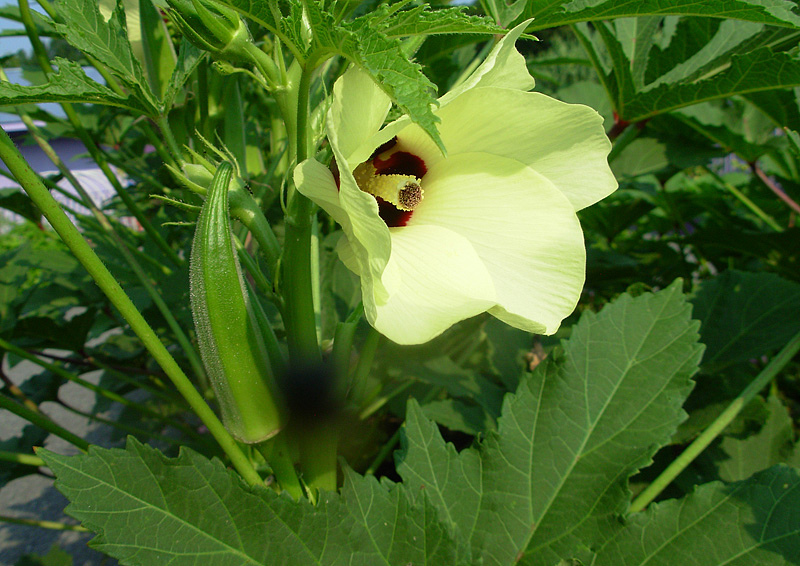
Okra flower and pods

Okra seed pod developing

Okra flower

Okra plant with flower

Okra flower buds

Okra with pods
Propagation
Basic requirements Okra is a heat loving plant, growing best in southern climates in a well draining, light sandy to medium loams. Soils should be high in organic matter with a pH between 5.8 to 6.8. If planting in clay soil, transplants are recommended due to the difficulty encountered in seedling emerging from the heavy soil. The plant should be grown in an area of high sunlight and grows best in hot temperatures. Soil temperatures should be at least 18.3°C (65°F) with optimal growth of the plants occurring at soil temperatures between 23.9–32.3°C (75–90°F). Propagation Okra is typically propagated from seed. Soaking seeds in water overnight prior to planting helps the plants to germinate. In the home garden, seeds should be sown at a depth of 2.5 cm (1 in) leaving 25–45 cm (10–18 in) between rows only after the soil has reached a temperature of 18°C (65°F). In commercial okra production, seeds are planted in rows spaced 0.65–1.0 m (26–40 in) apart. Okra seed is commonly planted at a rate of 10 lb per acre but this quantity is vastly reduced by the use of precision planting methods. Seedlings are thinned to a final spacing of 15.0–22.5 cm (6–9 in) when they are 4–6 weeks old to produce the final plant stand. General care and maintenance Okra requires a moist soil for optimum development. Water should be applied at a rate of 1.5 inches every 10 days is recommended in hotter areas. In cooler climates, plants require less water as it tends to cool the plants and restrict their growth. Okra benefits from the addition of nitrogen and phosphorous. Growers generally apply ammonium phosphate fertilizer that contain both nutrients at a rate of 100 lb per acre prior to planting seed. Chicken manure may be spread in place of chemical fertilizer 1 week prior to planting. An additional side dressing of 40–60 lb of nitrogen can be applied 6 weeks after planting. Due to the long period over which okra is harvested, weeds can become a problem and require management. in the home garden, weeds can be removed by careful cultivation of the soil around the plants. Applications of appropriate herbicides may be required in commercial production. Harvesting Pods are usually ready for harvesting 2 months after planting. Okra pods are generally ready to harvest 4 to 6 days after flowering and pods should be harvested every 2–3 days when they have reached 7.6–15.2 cm (3–5 in) in length. Pods can be removed from the plant by cutting with a sharp knife or by snapping from the plant.
Uses
The young seed pods are eaten fresh or cooked as a vegetable. The seeds can be used to extract oil. Okra fiber can be used in paper production.
References
Aguair, J. L., McGiffin, M., Natwick, E. & Takele, E. (2011). Okra production in California. UC Vegetable Research and Information Center. Available at: http://anrcatalog.ucdavis.edu/pdf/7210.pdf. [Accessed 27 February 15]. Free to access. CABI Crop Protection Compendium. (2008). Abelmoschus esculentus (okra) datasheet. Available at: http://www.cabi.org/cpc/datasheet/1950. [Accessed 27 February 15]. Paid subscription required. [Accessed 27 February 15]. Free to access.
Common Pests and Diseases
Diseases
Category : Fungal
Charcoal rot Macrophomina phaseolina
Symptoms
Discoloration of stem at soil line; cankers on stem may spread upwards; leaves may wilt and drop from plant; numerous small black sclerota (fungal fruiting bodies) develop in affected tissues and can be used to diagnose the disease
Cause
Fungus
Comments
Management
Rotate crop to non-host to reduce build-up of inoculum in the soil; avoid water stress to plants by irrigating when required
Fusarium wilt Fusarium oxysporum
Symptoms
Wilting of cotyledons and seedling leaves; cotyledons become chlorotic at the edges and then necrotic; older plants exhibit symptoms of wilting and leaf chlorosis; wilting is usually gradual but may be pronounced after heavy summer rain; if infection is severe plants become stunted and may be killed; vascular system of infected plants becomes discolored and can be seen by cutting the stem
Cause
Fungus
Comments
Management
Use on certified, disease-free seed; plant varieties with higher resistance to the disease in areas with a history of Fusarium diseases; fumigating the soil may reduce disease incidence
Powdery mildew Oidium asteris-punicei
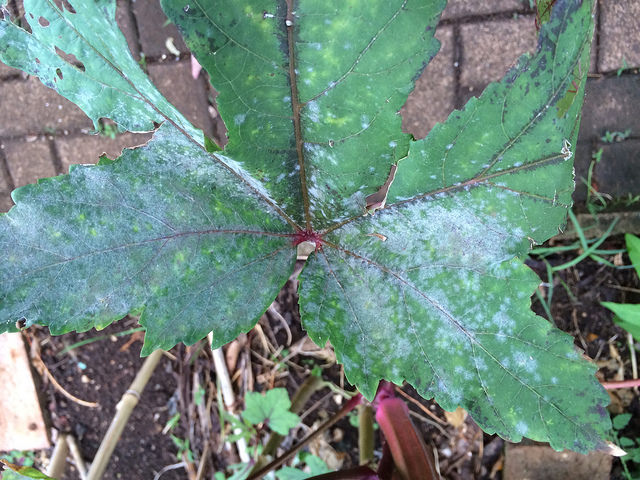
Powdery mildew on okra
Symptoms
Powdery white covering on leaves; patches may coalesce to cover entire plant; if plant is heavily infected leaves may roll upward and appear scorched
Cause
Fungus
Comments
Management
Use overhead irrigation (washes fungus from leaves and reduces viability); plant crop as early as possible; applications of appropriate fungicides may be necessary to control the disease
Southern blight Sclerotium rolfsii
Symptoms
Sudden wilting of leaves; yellowing foliage; browning stem above and below soil; browning branches; stem may be covered with fan-like mycelial mat
Cause
Fungus
Comments
Management
Remove infected plants; avoid overcrowding plants to promote air circulation; rotate crops with less susceptible plants; plow crop debris deep into soil; provide a barrier to infection by wrapping lower stems of plant with aluminum foil covering below ground portion of stem and 2-3 in above soil line
White mold Sclerotinia sclerotum
Symptoms
Flowers covered in white, cottony fungal growth; small, circular, dark green, water-soaked lesions on pods leaves and branches which enlarge and become slimy; cottony white growth may be visible on lesions during periods of high humidity; death of branches and/or entire plant
Cause
Fungus
Comments
Management
Rotate crops with non-hosts like cereals and corn; plant rows parallel to direction of prevailing winds to prevent spread of disease from secondary hosts nearby; avoid excessive nitrogen fertilizer; use a wide row spacing
Category : Viral
Enation leaf curl disease Okra Enation Leaf Curl Virus (OELCV)

Enation on infected leaves
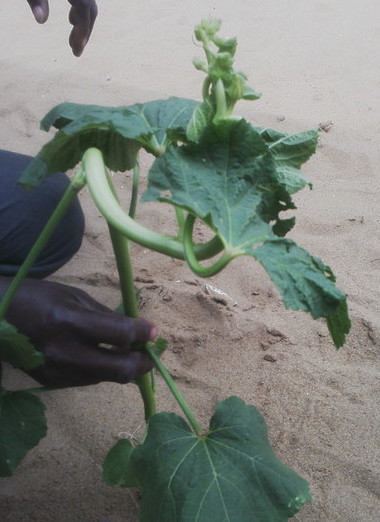
Twisting of stem and leaf petiole
Symptoms
On lower surface of leaves we will see a small pin head enations. This enation become warty and rough in structure at later stage. Reduce in leaf size. The stem, lateral branches and leaf petioles become twisted along enation. Leaves appear thick and leathery. In severely infected plants the emerging leaves shows bold enations and curling. And produce few deformed fruits.
Cause
Virus
Comments
Management
1. Remove the infected plant and burn them to avoid further spread of disease 2. Use yellow sticky traps to monitor whiteflies population 3. If the whiteflies infestation is more spray suitable insecticides.
Yellow Vein Mosaic Disease Bhendi Yellow Vein Virus (BYVMV)

Infected leaf
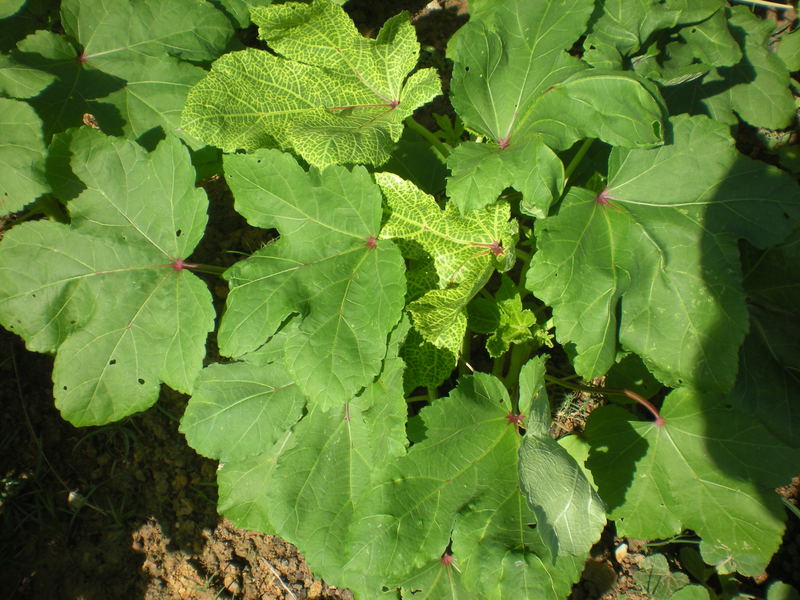
Yellow vein mosaic disease on mature plant

Yellow vein mosaic disease on young seedling
Symptoms
The infected leaves shows alternate patches of green and yellow. Veins become clear and chlorotic. With the progress of disease the veins become conspicuous and both vein and vein lets become thick. In advance stage the stems and leaf stalk become distorted. Fruits are yellowish green in color and small in size.
Cause
Virus
Comments
Management
Use resistant cultivars. Sow disease free certified seeds. Roughing of infected plants. Follow crop rotation. Keep the field free from weeds. Control vector with suitable insecticides.
Pests
Category : Insects
Aphids (Green peach aphid, Potato aphid, etc.) Myzus persicae
Macrosiphum euphorbiae
Symptoms
Small soft bodied insects on underside of leaves and/or stems of plant; usually green or yellow in color, but may be pink, brown, red or black depending on species and host plant; if aphid infestation is heavy it may cause leaves to yellow and/or distorted, necrotic spots on leaves and/or stunted shoots; aphids secrete a sticky, sugary substance called honeydew which encourages the growth of sooty mold on the plants
Cause
Insects
Comments
Management
If aphid population is limited to just a few leaves or shoots then the infestation can be pruned out to provide control; check transplants for aphids before planting; use tolerant varieties if available; reflective mulches such as silver colored plastic can deter aphids from feeding on plants; sturdy plants can be sprayed with a strong jet of water to knock aphids from leaves; insecticides are generally only required to treat aphids if the infestation is very high - plants generally tolerate low and medium level infestation; insecticidal soaps or oils such as neem or canola oil are usually the best method of control; always check the labels of the products for specific usage guidelines prior to use
Armyworms (Beet armyworm, Western striped armyworm) Spodoptera exigua
Spodoptera praefica
Symptoms
Singular, or closely grouped circular to irregularly shaped holes in foliage; heavy feeding by young larvae leads to skeletonized leaves; shallow, dry wounds on fruit; egg clusters of 50-150 eggs may be present on the leaves; egg clusters are covered in a whitish scale which gives the cluster a cottony or fuzzy appearance; young larvae are pale green to yellow in color while older larvae are generally darker green with a dark and light line running along the side of their body and a pink or yellow underside
Cause
Insect
Comments
Management
Organic methods of controlling armyworms include biological control by natural enemies which parasitize the larvae and the application of Bacillus thuringiensis; there are chemicals available for commercial control but many that are available for the home garden do not provide adequate control of the larvae
Corn earworm Helicoverpa zea
Symptoms
Larvae damage leaves, buds, flowers and pods; young caterpillars are cream-white in color with a black head and black hairs; older larvae may be yellow-green to almost black in color with fine white lines along their body and black spots at the base of hairs; eggs are laid singly on both upper and lower leaf surfaces and are initially creamy white but develop a brown-red ring after 24 hours and darken prior to hatching
Cause
Insect
Comments
Management
Monitor plants for eggs and young larvae and also natural enemies that could be damaged by chemicals; Bacillus thuringiensis or Entrust SC may be applied to control insects on organically grown plants; appropriate chemical treatment may be required for control in commercial plantations
Cucumber beetles (Western striped cucumber beetle, Western spotted cucumber beetle, Banded cucumber beetle) Acalymma vittata
Diabrotica undecimpunctata
Diabrotica balteata
Symptoms
Stunted seedling; damaged leaves, stems and/or petioles; reduced plant stand; plants may exhibit symptoms of bacterial wilt; scars on fruit caused by beetle feeding damage; adult beetles are brightly colored with either a green-yellow background and black spots or alternating black and yellow stripes
Cause
Insect
Comments
Management
Monitor new planting regularly for signs of beetle; floating row covers can be used to protect the plants from damage but will need to be removed at bloom to allow bees to pollinate plants; applications of kaolin clay can be effective for management of small beetle populations; application of appropriate insecticides may be necessary
Loopers (Cabbage looper) Trichoplusia ni
Symptoms
Large or small holes in leaves; damage often extensive; caterpillars are pale green with a white lines running down either side of their body; caterpillars are easily distinguished by the way they arch their body when moving; eggs are laid singly, usually on the lower leaf surface close to the leaf margin, and are white or pale green in color
Cause
Insect
Comments
Management
Looper populations are usually held in check by natural enemies; if they do become problematic larvae can be hand-picked from the plants; an organically acceptable control method is the application of Bacillus thuringiensis which effectively kills younger larvae; chemical sprays may damage populations of natural enemies and should and should be selected carefully
Thrips (Melon thrips) Thrips palmi
Symptoms
If population is high leaves may be distorted; leaves are covered in coarse stippling and may appear silvery; leaves speckled with black feces; insect is small (1.5 mm) and slender and best viewed using a hand lens; adult thrips are pale yellow to light brown and the nymphs are smaller and lighter in color
Cause
Insect
Comments
Management
Avoid planting next to onions, garlic or cereals where very large numbers of thrips can build up; use reflective mulches early in growing season to deter thrips; apply appropriate insecticide if thrips become problematic
Category : Nematodes
Root-knot nematode Meloidogyne spp.
Symptoms
Galls on roots which can be up to 3.3 cm (1 in) in diameter but are usually smaller; reduction in plant vigor; yellowing plants which wilt in hot weather
Cause
Nematode
Comments
Management
Plant resistant varieties if nematodes are known to be present in the soil ;check roots of plants mid-season or sooner if symptoms indicate nematodes; solarizing soil can reduce nematode populations in the soil and levels of inoculum of many other pathogens
Category : Mites
Spider mites (Two-spotted spider mite) Tetranychus urticae
Symptoms
Leaves stippled with yellow; leaves may appear bronzed; webbing covering leaves; mites may be visible as tiny moving dots on the webs or underside of leaves, best viewed using a hand lens; usually not spotted until there are visible symptoms on the plant; leaves turn yellow and may drop from plant
Cause
Arachnid
Comments
Management
In the home garden, spraying plants with a strong jet of water can help reduce buildup of spider mite populations; if mites become problematic apply insecticidal soap to plants; certain chemical insecticides may actually increase mite populations by killing off natural enemies and promoting mite reproduction
How To Plant Okra Seeds In A Garden
Source: https://plantvillage.psu.edu/topics/okra/infos
Posted by: mcnultyshosselame.blogspot.com

0 Response to "How To Plant Okra Seeds In A Garden"
Post a Comment